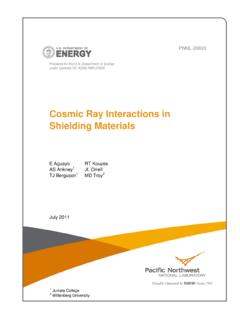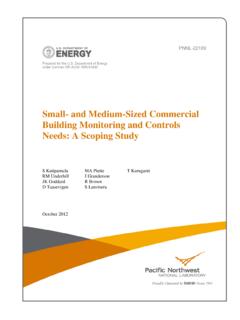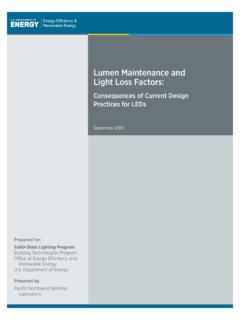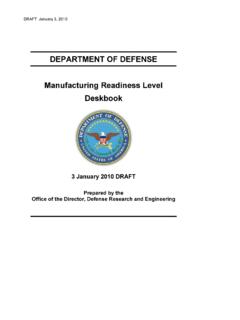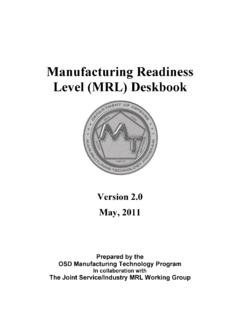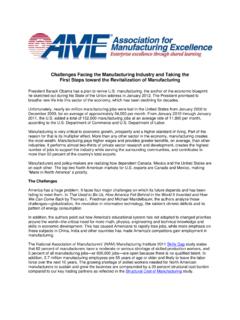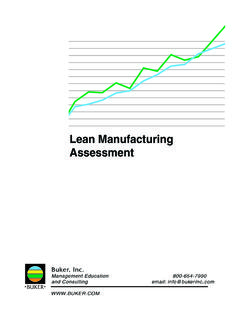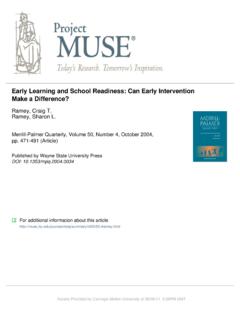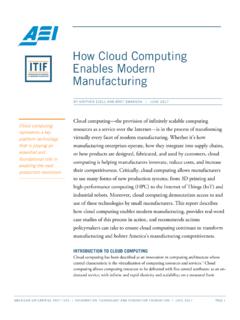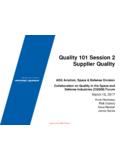Transcription of Development of Technology Readiness Level (TRL) Metrics ...
1 PNNL 21737 Prepared for the Department of Energy under Contract DE-AC05-76RL01830 Development of Technology Readiness Level (TRL) Metrics and Risk Measures DW Engel AC Dalton K Anderson C Sivaramakrishnan C Lansing October 2012 DISCLAIMER This report was prepared as an account of work sponsored by an agency of the United States Government. Neither the United States Government nor any agency thereof, nor Battelle Memorial Institute, nor any of their employees, makes any warranty, express or implied, or assumes any legal liability or responsibility for the accuracy, completeness, or usefulness of any information, apparatus, product, or process disclosed, or represents that its use would not infringe privately owned rights. Reference herein to any specific commercial product, process, or service by trade name, trademark, manufacturer, or otherwise does not necessarily constitute or imply its endorsement, recommendation, or favoring by the United States Government or any agency thereof, or Battelle Memorial Institute.
2 The views and opinions of authors expressed herein do not necessarily state or reflect those of the United States Government or any agency thereof. PACIFIC NORTHWEST NATIONAL LABORATORY operated by BATTELLE for the UNITED STATES DEPARTMENT OF ENERGY under Contract DE-AC05-76RL01830 Printed in the United States of America Available to DOE and DOE contractors from the Office of Scientific and Technical Information, Box 62, Oak Ridge, TN 37831-0062; ph: (865) 576-8401 fax: (865) 576-5728 email: Available to the public from the National Technical Information Service, Department of Commerce, 5285 Port Royal Rd., Springfield, VA 22161 ph: (800) 553-6847 fax: (703) 605-6900 email: online ordering: This document was printed on recycled paper. (9/2003) PNNL 21737 Development of Technology Readiness Level (TRL) Metrics and Risk Measures DW Engel AC Dalton K Anderson C Sivaramakrishnan C Lansing October 2012 Prepared for the Department of Energy under Contract DE AC05 76RL01830 Pacific Northwest National Laboratory Richland, Washington 99352 2 Contents Introduction.
3 3 Technology Readiness Level Assessment .. 3 CCSI Technology Readiness levels .. 4 Technology Readiness Risk Assessment .. 5 Gaps and Path Forward .. 7 Reference .. 8 Appendix: CCSI Technology Readiness Level (TRL) Questionnaire .. 10 Figures Figure 1 TRL uncertainty estimation (left side) and CDF (right side) assuming .. 6 Figure 2 TRL uncertainty estimation (left side) and CDF (right side), showing a comparison of assumed unertainty distributions (uniform, Log10 Normal, triangle) .. 8 Tables Table 1 Proposed TRL scale for carbon capture .. 4 Table 2 Example case showing probability of completing each TRL .. 6 Table 3 Example case showing probability of completing each TRL .. 7 3 Introduction Technology Readiness measures the extent to which a Technology is suited for deployment in a real operational environment.
4 It is often used as a measure of risk associated with introducing new technologies into existing systems and standard operating procedures. For the Carbon Capture Simulation Initiative (CCSI), Technology Readiness assessment is an indispensable component of the technical risk model and the functional system performance analysis. Technology Readiness assessment aims to evaluate the current carbon capture technologies maturity against a set of requisite technical, programmatic, and manufacturing indicators identified from the relevant literature and experts to enable a successful and accelerated transition of carbon capture technologies from conceptualization, discovery, and Development to eventual deployment. Technical Readiness assessment also provides the basis for technical risk assessment and uncertainty quantification (Engel 2012). In this report, we provide a brief overview of the current Technology Readiness assessment research, document the Development of Technology Readiness levels (TRLs) specific to carbon capture technologies, describe the risk measures and uncertainty quantification approaches used in our research, and conclude by discussing the next steps that the CCSI Task 7 team aims to accomplish.
5 Technology Readiness Level Assessment The current Technology Readiness research has two main focuses. In the psychometric centered Technology Readiness studies, the research focus is to understand consumers perception and beliefs about the maturity of a Technology or product, and to investigate the relationship between the perception of Technology Readiness and product adoption and acceptance behavior by consumers (Parasuraman 2000; Lin 2007; Heslop et al. 2001). Technology Readiness is conceptualized as consumers beliefs (Lin et al. 2007) regarding a Technology s usefulness, innovation, ease of application, and reliability (Parasuraman 2000). In Heslop et al. (2001) Technology Readiness assessment concentrates on attributes such as whether a Technology is new, a major scientific breakthrough or core Technology , whether background research is complete, and whether dominant alternatives exist (p.)
6 382). In addition to the strength of the Technology , adoption and commercialization depends on factors such as market appeal, available commercialization options, and managerial support. The common methodology used in these studies is consumer survey. Well established survey instruments such as Karasurman s Technology Readiness Index (2000) have been widely used in the business sector. Compared to consumer oriented Readiness research, Technology centered studies focus heavily on technological Development and system integration rather than consumer s perception of Technology maturity. This body of research examines the evolution of a Technology from conceptualization to exploratory studies, laboratory experiments and demonstration, real operational demonstration, and then full integration. Technology Readiness is evaluated by subdividing the Technology Development process into a number of clearly defined (but not necessarily linear) steps termed Technology Readiness levels (TRLs), and operationalizing each TRL with specific indicators to determine the Readiness Level of a Technology in view of the overall Readiness gradation scheme.
7 In this line of research, effort has been undertaken to develop and refine the instruments that characterize the maturity of technologies. The earliest TRLs were developed by the National Aeronautics and Space Administration (NASA) in the late 1980s and have been subsequently updated, modified and adopted by NASA, DOD and other government agencies with world wide adoption gaining momentum in early 2000 (see Mankins 1995; DHS 2009; Mankins 2009). Overtime TRL coverage has been expanded from exclusively technical indicators to include additional dimensions of Readiness Metrics such as hardware and software Readiness , system Readiness , programmatic Readiness , manufacturing Readiness , and integration Readiness (see DHS 2009 for a review and Smith 2004). 4 CCSI Technology Readiness levels The CCSI TRLs are similarly focused on the Technology Development , demonstration, and integration process of carbon capture technologies.
8 Based on the relevant literature and multiple existing TRL instruments, the research team sought to develop TRLs that are specifically tailored toward assessing the state of the art carbon capture technologies through computational modeling and simulation with the overarching objective of enabling accelerated commercialization and deployment of these technologies by the power industry (Engel 2012). The primary research goal for the TRL Development is to utilize the risk analysis to produce robust uncertainty measures. Table 1 provides an overview of the proposed Technology Readiness scales for carbon capture technologies for a hybrid, solid sorbent capture system with a two stage, counter currently connecting bubbling fluidized bed adsorber and a moving bed regenerator for a 650 MWe fossil fuel power plant. A total of nine levels were identified.
9 They can be divided into three Development stages. TRL 1, 2, and 3 measure the initial Technology proof of concept Development stage, TRL 4, 5, and 6 measure the Readiness for simulated or near real operational demonstrations with prototype models, and TRL 7, 8, and 9 measure the Readiness for use in an operational environment and full scale deployment. Table 1 Proposed TRL scale for carbon capture Technology Readiness Level (TRL) 9 Commercial operation in relevant environment 8 Commercial demonstration, full scale deployment in final form 650 MW 7 System prototype in an operational environment > 100 MW 6 Fully integrated pilot (prototype) tested in a relevant environment 10 50 MW 5 Component validation in relevant environment (coal plant) 1 MW 4 Component validation tests in laboratory environment 1 kW 3 Analytical and experimental critical function proof of concept 2 Formulation of application 1 Basic principles EPRI 2011 (Freeman and Bhown)
10 & GAO 2010 To assess the Readiness of carbon capture technologies, the team will recruit a group of experts from national laboratories, the academic community, and the power industry to provide assessment via a web based questionnaire. Toward that end, the project team identified concrete Readiness indicators for each of the nine Technology Readiness levels , and created the CCSI TRL Questionnaire (Appendix) for Readiness assessment elicitation. This questionnaire is currently hosted on the CCSI website. The CCSI TRLs have a few notable characteristics that help effectively address the shortfalls in the established TRL instruments.. A key criticism of the dominant TRLs is the failure to distinguish critical Technology components from non critical ones in Readiness assessment. To cope with this limitation, the indicators incorporated into the questionnaire were selected exclusively on the basis of criticality.






